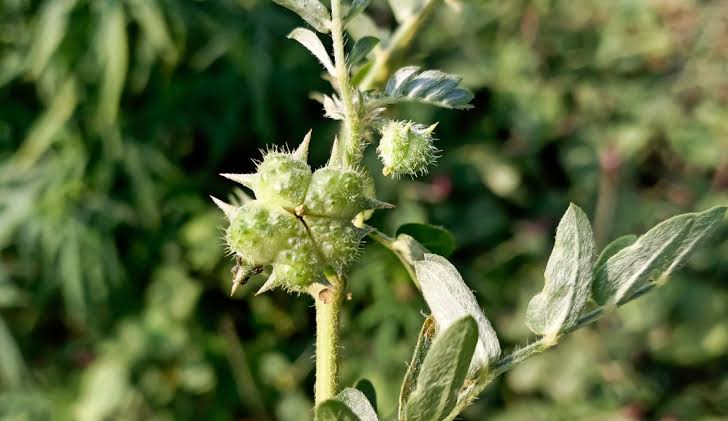Welcome to your holistic living

Botanical Name: Tribulus terrestris Linn
Family: Zygophyllaceae
English Name: Small caltrops
Malayalam Name: Nerungil
Hindi Name: Chota Gokhru
Gokṣura is a well-known drug in Ayurveda represented by two plants—Pedalium murex (family Pedaliaceae, called Braked Gokṣura) and Tribulus terrestris Linn. (family Zygophyllaceae, called Laghu Gokṣura). Pedalium murex is a glabrous annual herb with opposite, petiolate, irregularly toothed or lobed leaves. Its flowers are solitary, axillary, yellow, with a small calyx and four stamens, arising above two glands at the base. The fruit is a hard, indehiscent capsule, ovoid or pyramidal, bearing four spreading spines at the base. In contrast, Tribulus terrestris is a prostrate, weak, creeping herb with slender, branched stems and sub-opposite, even-pinnate compound leaves having 4–5 pairs of unequal oblong leaflets. Its bright yellow flowers are actinomorphic, bisexual, pentamerous, and hypogynous, with 5 free sepals and 5 obovate petals; stamens are 10, in two whorls, subtended by glandular scales, and the gynoecium is 2–5-carpellary with axile placentation. The fruit is a schizocarp, splitting into 5 spinous woody cocci, each containing one or more obliquely pendulous seeds. Grahya Lakṣaṇa (genuine characteristics): market samples of Gokṣura roots are slender, tortuous, 12–20 cm long and up to 1 cm thick, externally yellowish brown, wrinkled with prominent root scars; internally yellowish with a loosely adhering bark, pale cortex, and central woody portion showing concentric rings. They break into short powdery pieces, with faint agreeable odour and sweetish-astringent taste. The fruits are small, spherical, 5-lobed, up to 1 cm in diameter, hard, villous, greenish yellow, with flattened apex and dome-shaped base; each lobe bears four sharp rigid spines, and inside several small seeds occur in transversely separated compartments.
Root, fruit
Immunomodulatory Regulates immune response by stimulating macrophages and balancing cytokine production. Aphrodisiac Enhances libido and sexual performance by boosting androgen levels and nitric oxide activity. Diuretic Promotes urine flow and supports kidney function by increasing renal excretion. Anti-urolithic Helps prevent and dissolve kidney stones by reducing urinary oxalate and crystallization. Cardioprotective Supports heart health by improving lipid metabolism and reducing oxidative stress. Hepatoprotective Protects the liver from toxin-induced damage through antioxidant activity. Antidiabetic Lowers blood glucose by enhancing insulin sensitivity and glucose uptake. Antimicrobial Inhibits the growth of pathogenic bacteria and fungi through bioactive phytochemicals. Anti-inflammatory Reduces inflammation by downregulating pro-inflammatory mediators. Antioxidant Neutralizes free radicals and prevents oxidative stress-related tissue damage
Diuretic, Tonic, Aphrodisiac, Demulcent
Rasa: Madhura
Guna: Guru, Snigdha
Virya: Sita
Vipaka: Madhura
Dosha Karma: Tridosha shamaka